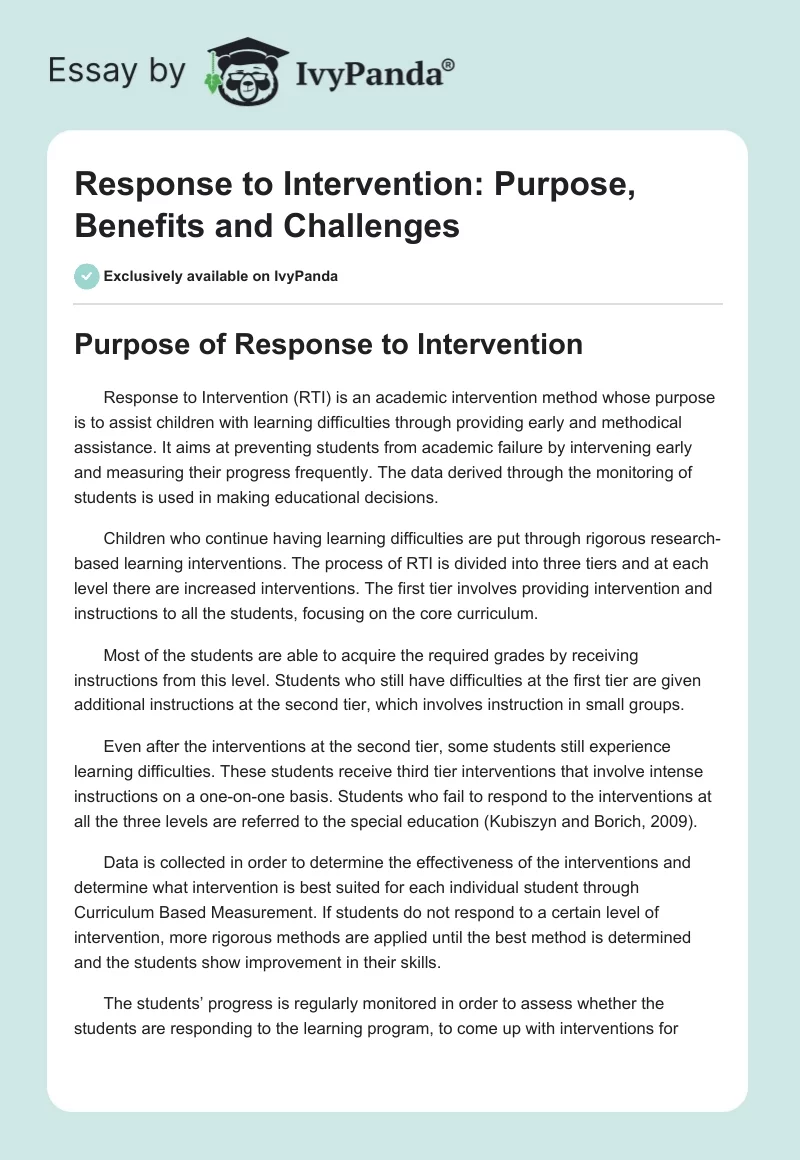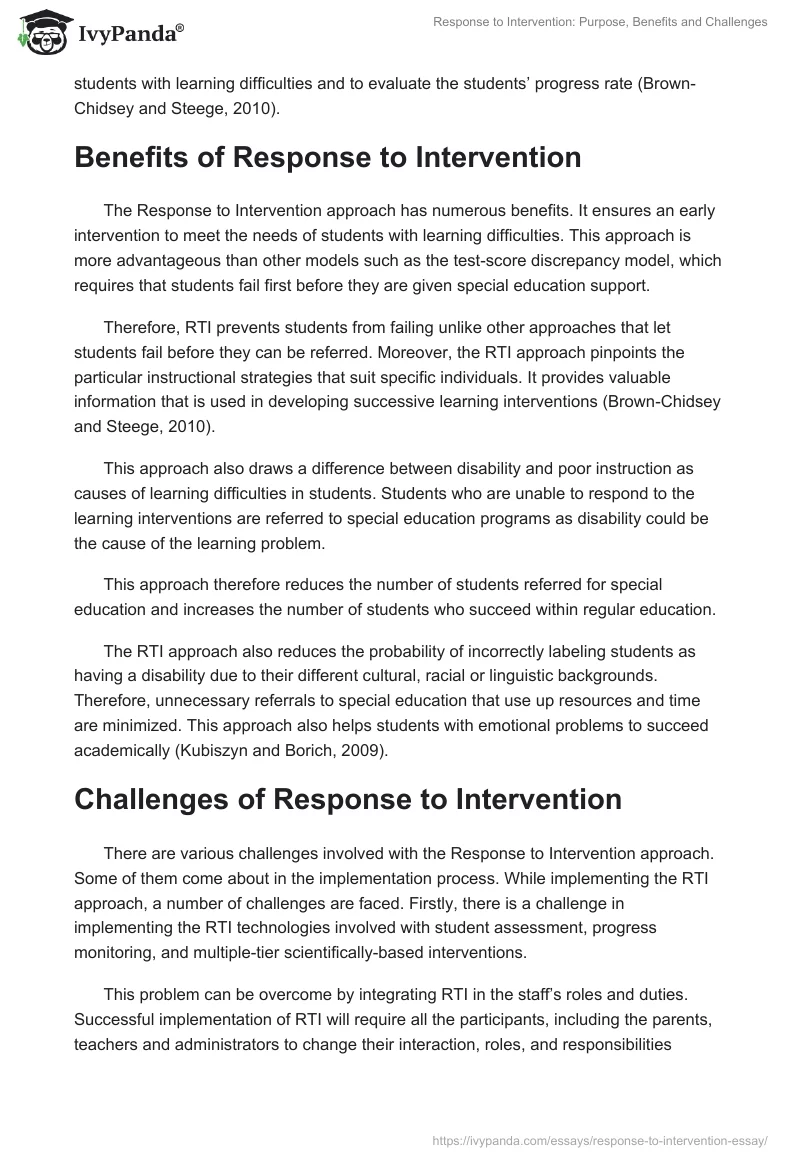Purpose of Response to Intervention
Response to Intervention (RTI) is an academic intervention method whose purpose is to assist children with learning difficulties through providing early and methodical assistance. It aims at preventing students from academic failure by intervening early and measuring their progress frequently. The data derived through the monitoring of students is used in making educational decisions.
Children who continue having learning difficulties are put through rigorous research-based learning interventions. The process of RTI is divided into three tiers and at each level there are increased interventions. The first tier involves providing intervention and instructions to all the students, focusing on the core curriculum.
Most of the students are able to acquire the required grades by receiving instructions from this level. Students who still have difficulties at the first tier are given additional instructions at the second tier, which involves instruction in small groups.
Even after the interventions at the second tier, some students still experience learning difficulties. These students receive third tier interventions that involve intense instructions on a one-on-one basis. Students who fail to respond to the interventions at all the three levels are referred to the special education (Kubiszyn and Borich, 2009).
Data is collected in order to determine the effectiveness of the interventions and determine what intervention is best suited for each individual student through Curriculum Based Measurement. If students do not respond to a certain level of intervention, more rigorous methods are applied until the best method is determined and the students show improvement in their skills.
The students’ progress is regularly monitored in order to assess whether the students are responding to the learning program, to come up with interventions for students with learning difficulties and to evaluate the students’ progress rate (Brown-Chidsey and Steege, 2010).
Benefits of Response to Intervention
The Response to Intervention approach has numerous benefits. It ensures an early intervention to meet the needs of students with learning difficulties. This approach is more advantageous than other models such as the test-score discrepancy model, which requires that students fail first before they are given special education support.
Therefore, RTI prevents students from failing unlike other approaches that let students fail before they can be referred. Moreover, the RTI approach pinpoints the particular instructional strategies that suit specific individuals. It provides valuable information that is used in developing successive learning interventions (Brown-Chidsey and Steege, 2010).
This approach also draws a difference between disability and poor instruction as causes of learning difficulties in students. Students who are unable to respond to the learning interventions are referred to special education programs as disability could be the cause of the learning problem.
This approach therefore reduces the number of students referred for special education and increases the number of students who succeed within regular education.
The RTI approach also reduces the probability of incorrectly labeling students as having a disability due to their different cultural, racial or linguistic backgrounds. Therefore, unnecessary referrals to special education that use up resources and time are minimized. This approach also helps students with emotional problems to succeed academically (Kubiszyn and Borich, 2009).
Challenges of Response to Intervention
There are various challenges involved with the Response to Intervention approach. Some of them come about in the implementation process. While implementing the RTI approach, a number of challenges are faced. Firstly, there is a challenge in implementing the RTI technologies involved with student assessment, progress monitoring, and multiple-tier scientifically-based interventions.
This problem can be overcome by integrating RTI in the staff’s roles and duties. Successful implementation of RTI will require all the participants, including the parents, teachers and administrators to change their interaction, roles, and responsibilities because the implementation of the program will broaden their responsibilities and commitments (Brown-Chidsey and Steege, 2010).
Furthermore, it is challenging to integrate the RTI approach into the school culture and structure that is in existence. Schools have been using other approaches to deal with learning difficulties and therefore introducing the RTI program is challenging.
There may be resistance to change. This challenge can be overcome by enlightening all the participants about the potential benefits of this approach in order to make them embrace it and participate effectively towards its implementation.
Moreover, the teachers may not be sufficiently trained in order to carry out the research-based interventions to ensure a successful implementation of the RTI program. In addition, if the teachers have low expectations about the effectiveness of the program, they may not be fully committed to it and this might lead to its failure.
This challenge can be overcome by ensuring that teachers receive comprehensive training on all the aspects of the RTI program before it is implemented in order to ensure its success. Other challenges faced in implementing the RTI program include overcoming funding and leadership changes, classroom management, and scheduling.
With proper planning and preparation of all the participants, these challenges can be overcome and the RTI program can run smoothly. In addition, most schools lack the necessary technical resources for the implementation of RTI.
This challenge can be overcome by petitioning the government and other charitable organizations to provide enough funds for acquiring sufficient resources to implement and run the RTI (Brown-Chidsey and Steege, 2010).
The Response to Intervention program has been successful in early detection of learning disabilities. However, this approach has some limitations. There are challenges involved with the effectiveness of the approach. The RTI approach is criticized for delaying the process of identifying the students who need special education.
In addition, while attempting to minimize the number of students who are referred, the RTI approach may deny eligible students the chance for special education referral. It is also difficult to accurately determine whether a learning disability exists.
These limitations can be overcome by reviewing the RTI process in order to come up with the most effective solution for each individual student. Moreover, rigorous training should be provided to the teachers in order to ensure that accurate results are achieved and all students benefit from the program (Brown-Chidsey and Steege, 2010).
Importance of Early Intervention
Early intervention enables the early identification of students who may have learning disabilities and therefore their needs are addressed early. This increases their academic success. The children start getting help from an early age and this ensures that their academic foundation is strong from the beginning. Early detection of learning disabilities enables the children to get help in order to reach their potential.
If intervention is not done early, the child will continually perform poorly in school and this will lead to more frustration. They may develop problems such as low self-esteem and can even drop out of school.
Failure to detect and treat learning disabilities early can affect the literacy, education, and job prospects of an individual as an adult. Early identification of learning disabilities greatly increases the chances of the child excelling in school (Kubiszyn and Borich, 2009).
Reference List
Brown-Chidsey, R. and Steege, M.W. (2010). Response to Intervention: Principles and Strategies for Effective Practice, 2nd Ed. New York: Guilford Press.
Kubiszyn, T. and Borich, G.D. (2009). Educational Testing and Measurement: Classroom Application and Practice, 9th Ed. USA: John Wiley & Sons.


